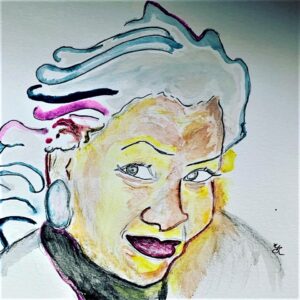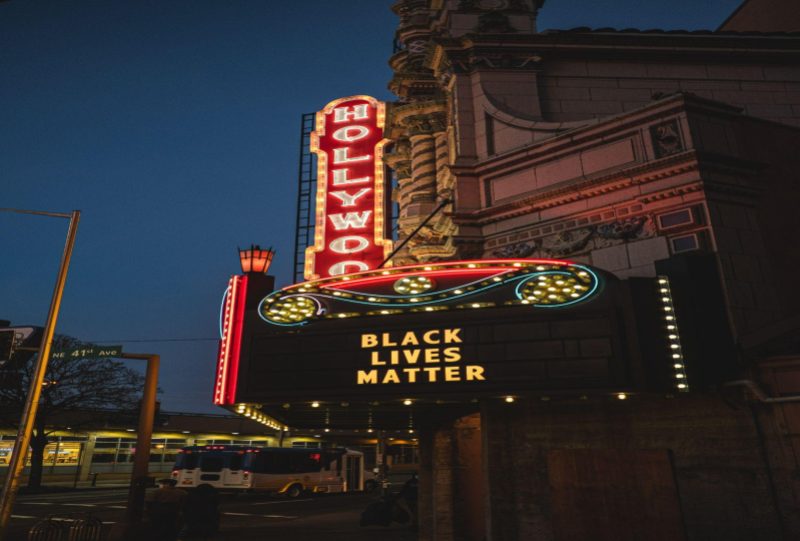Nothing has as much durability as a racialized trope.
Memories of 60’s television include racing downstairs with my cousins to see the “Negro” who had been spotted in a soap commercial. Believe me, it was a race-worthy event (pun fully intended). At that time, Black bodies were rarely represented in the media except in highly caricatured roles. Yes, the brilliantly talented Arthur Duncan was tap dancing his way to stardom on the Lawrence Welk show, but frankly, what else was he expected to do? How else could he and “Rochester” occupy space in the white supremacist imagination that produced 20th-century television? But let’s leave that century behind and fast forward to now.
Because I’m always in search of a binge-worthy mystery series, I accepted a recommendation to watch the 2022 television series, Night Sky. Although I had been duly forewarned about sci-fi elements (never my favorites in any film), I decided that with Sissy Spacek and J.K. Simmons in the lead roles, the show had to have some redemptive value.
Ok, so – SPOILER ALERT to anyone who might be inclined to watch it: Spacek and Simmons play an elderly, white, small-town midwestern couple, whose only son lived with debilitating depression. In one scene, their son is seated at his parent’s dinner table accompanied by a dark-skinned, Black woman whom he introduced as his fiancée. In another scene, there’s a fraught conversation with his mother about his illness, then the sound of gunshot, signifying his death by suicide. Sometime later, a twenty-something, light-skinned, Black woman (“Denise”) comes through the door looking for “Grandma” and “Grandpa”. The writers pour a lot of verbiage into depicting the mutual devotion between paternal grandparents and this young woman. Denise seems to have a few white MBA classmates and corporate fast lane colleagues, as well as an old “hometown” friend (also white) who offers a couch for crashing, bar shots, karaoke, and taunting skepticism about affirmative action.
Denise’s racial consciousness seems limited to (a) asking her grandma if the distance between them is caused by her Blackness and (b) wearing some kind of ethnic headgear for sleeping. Episode after clunky episode, Denise interacts with various quirky and sometimes nefarious characters, but all of these encounters beg a glaring question: Where is her mother? Aside from that one convivial dinner and Denise’s melanin count, there is no evidence that she ever existed. What happened to that dark-skinned woman? She is simply disappeared. With multiple plots and sub-plots ricocheting against each other (“plots on plots on plots” as the kids say), the season stumbles to its ending, this time finding Denise teleported to Bangkok with a white (ish) dude; a dude who is hunted by cult killers, who has killed to escape the cult, and who has no visible means of support. I sat dumbfounded by the ending, and its message, still thinking: Damn. Really, Gurl. Where is your mother?
I think they dispensed with the mother by saying that she had remarried and moved on. In other words, no need to understand her or her connection with her daughter. Removed from the plot, she is removed from Denise and from our minds. Neither she nor her relationship with her daughter matters.

In her brilliant volume Playing in the Dark, author Toni Morrison has a name for this particular trope: natal isolation. Here’s how it works:
- Take a Black character, (any genders work) and strip them of relational context, and they are no longer fully agentive in their own right.
- Give them purpose – to serve and protect the needs, the comforts, and the entitlements of whiteness. This is how #blacklivesmatter for white supremacy.
- Present this schema as normal and mutually valued by the Black character.
In all of this focus around the Black character’s individual purpose, the real star is “whiteness.” It’s a mistake to think of “whiteness” as an individual, or even readily visible. This kind of supremacist imagination is more of an organizing ethos. White supremacist imagination isn’t just the rope-lynching, extra-judicial killing kind. It’s the imagination that relentlessly centers itself as the unilateral arbiter of what is good, what is true, what is beautiful, what is worthy, what is normal. It is the imagination that renders Black bodies fully accessible to white bodies – available to do whatever is necessary to highlight the importance of white bodies. It doesn’t even matter if the white bodies are heroic or villainous. What matters is their centrality. What matters is the fact that their lives matter.
From Gone with the Wind to The Secret Life of Bees to The Help to the egregiously offensive Monsters Ball (certainly not begrudging Halle Berry her Oscar), black women are isolated from any semblance of meaningful community. In this phantasmagoric film Monster’s Ball, Berry’s/ “Leticia’s” son must die and her friends must abandon her so that she can be available to redeem Billy Bob Thornton’s (“Grotowski”) bitter heart through her lust (enter Jezebel) for him. The point is witless devotion to the white supremacist imagination. As I said, gender is mostly irrelevant. It still boggles my mind that African American pianist, Dr. Don Shirley, was relegated to a supporting role in a movie that was ostensibly about his 1962 tour in the American South. The highest achiever, the perceived protagonist, is stripped down to the role of cheerleader for his white driver.
The natal isolation trope has durability because it can be prettified. We always cherish prettified things, especially if they make us feel pretty. Think of it as racism gift wrapped with satin bows. This trope is easily and often mixed with the most ubiquitous trope of racialized accommodation: the magical Negro.
Look no further than the impressive oeuvre of the peerless Mr. Poitier to find examples of both. From straggling through the Lilies of the Field to appearing at the dinner table of San Francisco socialites, Mr. Poitier dons the mantle of extraordinariness to earn begrudging respect from fairly ordinary white people. He must come to the table bringing accomplishments that outshine those of his hosts, and his fiancée while reducing himself to fit into the tight boundaries of their supremacist imaginations. According to the 20th-century rules of “Playing in the Dark”, Black bodies must prove their worth (e.g., utility, devotion, respectability) to white bodies. The 21st-century rules haven’t changed – they’ve been disguised. Sometimes it takes a “Wait. What?” before these white supremacist imaginings become visible.

I loved the apocalyptic satire Don’t Look Up. But why would the Black scientist “Dr. Teddy Oglethorpe” spend his last moments at the dinner table (truly the last supper for all) of his white ad hoc colleagues? All of the white actors in the scene had a reason for being at the table. This dude just popped up as a guest with nice manners and a bottle of wine. There was nothing in the plot to suggest that he and his colleagues shared an even casual friendship. Shouldn’t he have had an old auntie, an ex-partner, a child… somebody he would have wanted to spend the “end of times” with? Was his life so devoid of natal community that his only option was to insert himself into this fragile, newly reconstituted crew? Perhaps the filmmakers didn’t want to invest more in the movie by hiring “extras “and setting up a whole new dinner table. I don’t know, but I have to say that I was relieved and delighted when a white colleague from North Carolina noticed that something was seriously amiss. In her inimitable style, Kate exclaimed: “Where is that black man’s family?! Why is he alone?” And that’s the point: we must interrogate what looks normal. We must ask how his presence serves white supremacist imagination. Did he earn his seat with his intellect? Did his presence render his hosts more “woke”? Was this a “we’re color-blind in the face of the apocalypse” moment, especially for dutiful, Black people whose utility levels reach the stratosphere?”
Racialized tropes die hard, and frankly, they can sneak up on you, especially in the 21st century. Prettified and normalized, they constrict and poison our imaginations of human community. They are ever generative, breeding those invisible biases that we dare not see and speak – even when unabashedly splayed on the silver screen and our streaming channels. So here we are – after seventy-plus years of lauded, applauded, award-winning films and television – and we’re still playing in the dark.




As always, you lift the veil and offer a thought provoking, compelling, fully realized view of what is right in front of us, AND you are compassionate enough to make us laugh while we are looking.
once again you pull back the curtain to show that the “wizard” is really bojangles.
thx for the insight.
nick
WHOA. Reading your piece, my mind began racing with all the tropes I have witnessed but never understood them in the context that you so thoughtfully shared in your piece. It never ceases to amaze me at how thorough white people in “power” can be in trying to maintain the status quo. Appreciate reading this so very much Maureen.